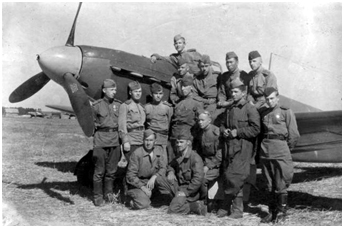
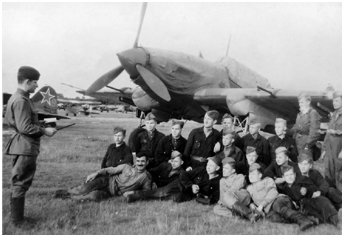 When World War II ended in Europe, four reconnaissance units had reached the territory of the Reich. These were the 93. and 98.OKRAP, the 72.ORAP, as well as the 16.ODRAP, all subordinate to the 16.VA. The 93. and 98.OKRAP had an inventory of fairly similar aircraft adapted to their spotting (artillery adjustment) and reconnaissance mission, namely Il-2KR, Po-2 including certainly Po-2NAK as well as Yak-9R or D. The assignment of fighter aircraft rather dedicated to ground attack was also possible. Thus, the 93.OKRAP, which was set up on the basis of the 25.OKRAE in February 1944, fielded two Yak-9K alongside seven Yak-9R in April 1945. The Yak-9K (K for Krupnokaliberniy - large caliber) was distinguished by a nose-mounted 45mm NS-45 cannon and an increased fuel capacity. It was derived from the Yak-9T armed with a 37mm NS-37 cannon. The Yak-9K was only built in 53 units in 1944 and it notably participated in the operations against Berlin, whose honorary name the 93.OKRAP bore.
The Yak-9R (R for Razvedchik - reconnaissance) was a Yak-9 fighter with an AFA-IM camera mounted in a ventral position behind the pilot and protected by a retractable hatch. Another version of Yakovlev's fighter based on the Yak-9D airframe (D for Dal'niy - farther) with a greater range used an AFA-3s/50 camera. We will not dwell on the Il-2KR and the U-2/Po-2(NAK), nor on the 98.OKRAP, because these subjects have been addressed for the first two and widely studied for the third in the article entitled "Flight Logs" > Link.
The stay of the 93.OKRAP in Germany was short-lived. It was based in Topper (Ostbrandenburg) in April 1945 then in Oranienburg, and, already in January 1946, the unit left for Insterburg (now Tcherniakhovsk in the Kaliningrad oblast).
When World War II ended in Europe, four reconnaissance units had reached the territory of the Reich. These were the 93. and 98.OKRAP, the 72.ORAP, as well as the 16.ODRAP, all subordinate to the 16.VA. The 93. and 98.OKRAP had an inventory of fairly similar aircraft adapted to their spotting (artillery adjustment) and reconnaissance mission, namely Il-2KR, Po-2 including certainly Po-2NAK as well as Yak-9R or D. The assignment of fighter aircraft rather dedicated to ground attack was also possible. Thus, the 93.OKRAP, which was set up on the basis of the 25.OKRAE in February 1944, fielded two Yak-9K alongside seven Yak-9R in April 1945. The Yak-9K (K for Krupnokaliberniy - large caliber) was distinguished by a nose-mounted 45mm NS-45 cannon and an increased fuel capacity. It was derived from the Yak-9T armed with a 37mm NS-37 cannon. The Yak-9K was only built in 53 units in 1944 and it notably participated in the operations against Berlin, whose honorary name the 93.OKRAP bore.
The Yak-9R (R for Razvedchik - reconnaissance) was a Yak-9 fighter with an AFA-IM camera mounted in a ventral position behind the pilot and protected by a retractable hatch. Another version of Yakovlev's fighter based on the Yak-9D airframe (D for Dal'niy - farther) with a greater range used an AFA-3s/50 camera. We will not dwell on the Il-2KR and the U-2/Po-2(NAK), nor on the 98.OKRAP, because these subjects have been addressed for the first two and widely studied for the third in the article entitled "Flight Logs" > Link.
The stay of the 93.OKRAP in Germany was short-lived. It was based in Topper (Ostbrandenburg) in April 1945 then in Oranienburg, and, already in January 1946, the unit left for Insterburg (now Tcherniakhovsk in the Kaliningrad oblast).
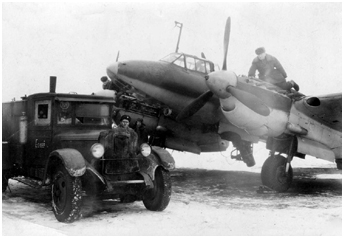
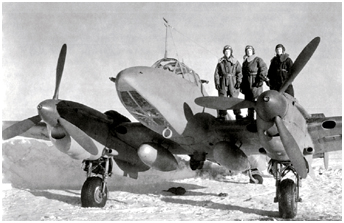 As for the 98.OKRAP, also based in Ostbrandenburg on the Warnitz airfield (1) in April 1945, it remained in Germany until 1991 when, finally designated the 931.OGRAP, its last MiG-25 left Werneuchen for Welzow - the Yak-27, Yak-28 and MiG-25 periods of the 931.OGRAP are studied in parts > 5, > 6 and > 7 of this chapter.
A third unit occupied an airfield located in Eastern Brandenburg; the 72.ORAP "Petrozavodsk" reached Wormsfelde (today Wojcieszyce), also in April 1945.
This regiment had been set up in February 1939 in Besovets (Petrozavodsk in Karelia) as the 72.SAP (with I-153 and SB). Transformed into the 72.SBAP, then into a BAP, it was equipped with Pe-2 bombers at the beginning of
1942. On November 20, the unit was finally redesignated the 72.ORAP. In 1945, the regiment flew Petlyakov Pe-2R. Different reconnaissance versions of the Pe-2 coexisted depending on the bomber's production series. Some aircraft were also converted into units. However, the Pe-2R - simply designated Pe-2 in unit reports - shared some characteristics with each other. In order to facilitate photography, an AK-1 gyroscopic heading indicator acted on the rudders to maintain the heading with a drift limited to 1 or 2°. The system also allowed turns to be executed by the pilot or the navigator. The controls for dive bombing were removed and the airbrakes were not factory-fitted. In addition to the AFA-B camera located under the radio-gunner's position at the rear and which was also mounted on the bomber versions, one or two AFA-1 cameras with a focal length of 30 or 50 cm, were fixed in the bomb bay. The installation of these bulky cameras required the replacement of the bomb bay doors with bulged doors with cut-outs for the cameras whose lenses protruded outside.
As for the 98.OKRAP, also based in Ostbrandenburg on the Warnitz airfield (1) in April 1945, it remained in Germany until 1991 when, finally designated the 931.OGRAP, its last MiG-25 left Werneuchen for Welzow - the Yak-27, Yak-28 and MiG-25 periods of the 931.OGRAP are studied in parts > 5, > 6 and > 7 of this chapter.
A third unit occupied an airfield located in Eastern Brandenburg; the 72.ORAP "Petrozavodsk" reached Wormsfelde (today Wojcieszyce), also in April 1945.
This regiment had been set up in February 1939 in Besovets (Petrozavodsk in Karelia) as the 72.SAP (with I-153 and SB). Transformed into the 72.SBAP, then into a BAP, it was equipped with Pe-2 bombers at the beginning of
1942. On November 20, the unit was finally redesignated the 72.ORAP. In 1945, the regiment flew Petlyakov Pe-2R. Different reconnaissance versions of the Pe-2 coexisted depending on the bomber's production series. Some aircraft were also converted into units. However, the Pe-2R - simply designated Pe-2 in unit reports - shared some characteristics with each other. In order to facilitate photography, an AK-1 gyroscopic heading indicator acted on the rudders to maintain the heading with a drift limited to 1 or 2°. The system also allowed turns to be executed by the pilot or the navigator. The controls for dive bombing were removed and the airbrakes were not factory-fitted. In addition to the AFA-B camera located under the radio-gunner's position at the rear and which was also mounted on the bomber versions, one or two AFA-1 cameras with a focal length of 30 or 50 cm, were fixed in the bomb bay. The installation of these bulky cameras required the replacement of the bomb bay doors with bulged doors with cut-outs for the cameras whose lenses protruded outside.
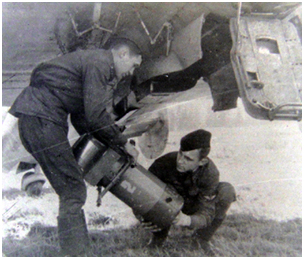
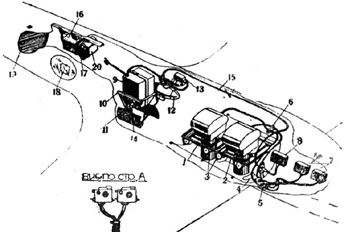 The AFA-B was sometimes replaced by a NAFA-19 for night photography, which involved carrying 6 to 8 FOTAB-35 or -50 flare bombs. The radio operator also had a hand-held AFA-27T-1 camera to take perspective photographs from his position. AFA-3s and American-made cameras received under the Lend-Lease program were also used. Additional fuel tanks made of paper treated with cellulose sulfate and casein glue were often mounted under the hardpoints located between the engines and the fuselage. It should be noted that there was also a reconnaissance version of the fighter derived from the "Peshka", namely the Pe-3R.
Yak-9R or D and Pe-2R were complementary. If the Pe-2 was more effective (better visibility, crew of three), the Yak-9 stood out in areas where fighters and anti-aircraft defenses were more active. Although subordinate to the 16.VA since December 1944, the 72.ORAP was a unit of the Stavka (the supreme high command) reserve. It quickly moved to Werneuchen in May 1945 and left German territory for good in July of the same year.
The 16.ODRAP "Stalingrad" (independent long-range reconnaissance aviation regiment) followed the same path as the 72.ORAP at the end of the war, moving to Wormsfelde airfield in April 1945 and then to Werneuchen in May. The regiment was set up on the basis of the 325.ORAE in December 1942 with Pe-2. It was composed in 1945 of the 1.AE flying Pe-2R, the 2.AE equipped with Pe-2R and "Bostons" (20 exemplars received in 1943) and the 3.AE armed with long-range Yak-9D. A report from July 1944 (> Link) informs us that these fighters were used for "reconnaissance on the battlefield and control of the adjacent roads." At that time, nine Yaks, eight Pe-2 and three "Bostons" were airworthy.
A C-47 also was part of 16.ODRAP, which flew 71 combat sorties "deep behind enemy lines." These may have been support flights for the partisans. A proposal to transform the regiment into a guards unit was submitted in January 1945 to the headquarters of the 16th VA, but was not followed up (> Link). In February 1949, the regiment was redesignated the 886.ORAP. Two years later, it took on Tu-6 to replace its Pe-2R.
The AFA-B was sometimes replaced by a NAFA-19 for night photography, which involved carrying 6 to 8 FOTAB-35 or -50 flare bombs. The radio operator also had a hand-held AFA-27T-1 camera to take perspective photographs from his position. AFA-3s and American-made cameras received under the Lend-Lease program were also used. Additional fuel tanks made of paper treated with cellulose sulfate and casein glue were often mounted under the hardpoints located between the engines and the fuselage. It should be noted that there was also a reconnaissance version of the fighter derived from the "Peshka", namely the Pe-3R.
Yak-9R or D and Pe-2R were complementary. If the Pe-2 was more effective (better visibility, crew of three), the Yak-9 stood out in areas where fighters and anti-aircraft defenses were more active. Although subordinate to the 16.VA since December 1944, the 72.ORAP was a unit of the Stavka (the supreme high command) reserve. It quickly moved to Werneuchen in May 1945 and left German territory for good in July of the same year.
The 16.ODRAP "Stalingrad" (independent long-range reconnaissance aviation regiment) followed the same path as the 72.ORAP at the end of the war, moving to Wormsfelde airfield in April 1945 and then to Werneuchen in May. The regiment was set up on the basis of the 325.ORAE in December 1942 with Pe-2. It was composed in 1945 of the 1.AE flying Pe-2R, the 2.AE equipped with Pe-2R and "Bostons" (20 exemplars received in 1943) and the 3.AE armed with long-range Yak-9D. A report from July 1944 (> Link) informs us that these fighters were used for "reconnaissance on the battlefield and control of the adjacent roads." At that time, nine Yaks, eight Pe-2 and three "Bostons" were airworthy.
A C-47 also was part of 16.ODRAP, which flew 71 combat sorties "deep behind enemy lines." These may have been support flights for the partisans. A proposal to transform the regiment into a guards unit was submitted in January 1945 to the headquarters of the 16th VA, but was not followed up (> Link). In February 1949, the regiment was redesignated the 886.ORAP. Two years later, it took on Tu-6 to replace its Pe-2R.
| ORBAT 1945 - 1993 |
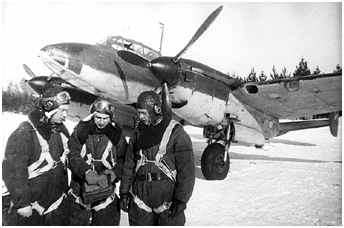
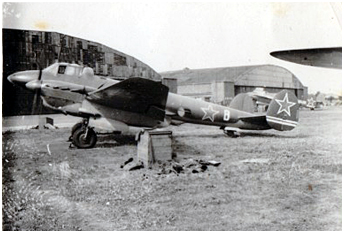 Experiments to modify Tupolev Tu-2 bombers - which were also equipped by default with an AFA-B camera - into reconnaissance versions began in 1942 with six aircraft. They were initially to carry an additional 750-litre tank installed in the bomb bay as well as two AFA-3s cameras mounted on laterally orientable cradles also mounted in the bomb bay whose doors had an additional hatch. The first three aircraft were operationally tested within the 2.APDR (long-range reconnaissance aviation regiment) between December 1942 and January 1943. More Tu-2 were modified during the summer to serve with the same unit, which joined the ranks of the Guards on February 8, 1943 to become the 47.GAPDR (47.OGRAP in July 44). A new configuration for night reconnaissance designated Yavor (Sycamore) was first tested in the winter of 1944-45 on a Tu-2.
Taking pictures at night was limited by the number of flare bombs that the aircraft could carry. Instead, a set of flashes whose tungsten filaments could be replaced in flight, was mounted in the bomb bay .
It was therefore possible to take much more pictures with that setup. Although development of the system continued until the mid-fifties with a view to mounting the apparently satisfactory "Yavor-3" version on board the Il-28, no operational development followed.
Experiments to modify Tupolev Tu-2 bombers - which were also equipped by default with an AFA-B camera - into reconnaissance versions began in 1942 with six aircraft. They were initially to carry an additional 750-litre tank installed in the bomb bay as well as two AFA-3s cameras mounted on laterally orientable cradles also mounted in the bomb bay whose doors had an additional hatch. The first three aircraft were operationally tested within the 2.APDR (long-range reconnaissance aviation regiment) between December 1942 and January 1943. More Tu-2 were modified during the summer to serve with the same unit, which joined the ranks of the Guards on February 8, 1943 to become the 47.GAPDR (47.OGRAP in July 44). A new configuration for night reconnaissance designated Yavor (Sycamore) was first tested in the winter of 1944-45 on a Tu-2.
Taking pictures at night was limited by the number of flare bombs that the aircraft could carry. Instead, a set of flashes whose tungsten filaments could be replaced in flight, was mounted in the bomb bay .
It was therefore possible to take much more pictures with that setup. Although development of the system continued until the mid-fifties with a view to mounting the apparently satisfactory "Yavor-3" version on board the Il-28, no operational development followed.
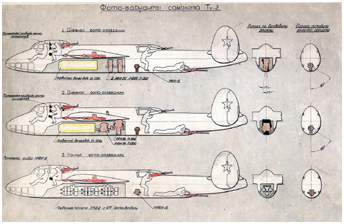
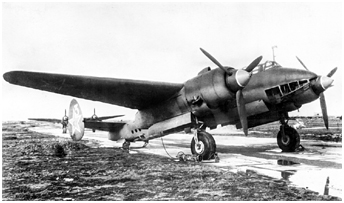 It was only at the end of 1945 that the complete set of equipment for a serial version of the Tu-2R was finally decided. The RSI-6 autopilot system for dive bombing was no longer mounted. There were an additional 700-750 liter tank and two AFA-3s or AFA-33 cameras of different focal lengths mounted in the bomb bay. A removable aerodynamic fairing was added around the lenses under the belly of the aircraft when AFA-33 cameras of long focal length were mounted in the rear of the bomb bay on a tilting AKAFU-156 cradle. The original location of the AFA-B camera was located under the radio-gunner's position. This camera could be replaced by an AFA-IM or even a NAFA-3s or a NAFA-19 for night missions. In this case, the bomb bay fuel tank was replaced by a PKD-2 rack on which were fixed nine FOTAB-35 or -50 flare bombs.
It was not until August 1947 that the reconnaissance version of the Tu-2 was accepted into service and that a real serial production began. The series aircraft were not designated Tu-2R, but Tu-6, i.e. the first dedicated reconnaissance aircraft built in series in the USSR. Without precise information available, the Western intelligence services identified these aircraft as Tu-2. The 886.ORAP left Werneuchen in 1951, to settle in Schönwalde precisely on July 5, 1951 according to the BND. We then find the regiment in Oranienburg on September 6, 1951, where the personnel follow their conversion on Il-28 with the 24.BAP (which left in October). The 886.ORAP was then based in Altes Lager with its Il-28R between January 23, 1952 and February 21, 1953, when the regiment left Germany for Jekabpils in Latvia.
In October 1951, it was the turn of the 48.OGRAP "Nizhnednestrovsky" (Lower Dniester) to land in Schönwalde after leaving its last base in the USSR located in Volchansk.
This unit finds its origins in the 40.BAP transformed into the 40.ODRAP in December 1941, while it was flying Pe-2 and Pe-3. On August 2, 1943, it became the 48.GAPDR and finally the 48.OGRAP in July 1944.
It was only at the end of 1945 that the complete set of equipment for a serial version of the Tu-2R was finally decided. The RSI-6 autopilot system for dive bombing was no longer mounted. There were an additional 700-750 liter tank and two AFA-3s or AFA-33 cameras of different focal lengths mounted in the bomb bay. A removable aerodynamic fairing was added around the lenses under the belly of the aircraft when AFA-33 cameras of long focal length were mounted in the rear of the bomb bay on a tilting AKAFU-156 cradle. The original location of the AFA-B camera was located under the radio-gunner's position. This camera could be replaced by an AFA-IM or even a NAFA-3s or a NAFA-19 for night missions. In this case, the bomb bay fuel tank was replaced by a PKD-2 rack on which were fixed nine FOTAB-35 or -50 flare bombs.
It was not until August 1947 that the reconnaissance version of the Tu-2 was accepted into service and that a real serial production began. The series aircraft were not designated Tu-2R, but Tu-6, i.e. the first dedicated reconnaissance aircraft built in series in the USSR. Without precise information available, the Western intelligence services identified these aircraft as Tu-2. The 886.ORAP left Werneuchen in 1951, to settle in Schönwalde precisely on July 5, 1951 according to the BND. We then find the regiment in Oranienburg on September 6, 1951, where the personnel follow their conversion on Il-28 with the 24.BAP (which left in October). The 886.ORAP was then based in Altes Lager with its Il-28R between January 23, 1952 and February 21, 1953, when the regiment left Germany for Jekabpils in Latvia.
In October 1951, it was the turn of the 48.OGRAP "Nizhnednestrovsky" (Lower Dniester) to land in Schönwalde after leaving its last base in the USSR located in Volchansk.
This unit finds its origins in the 40.BAP transformed into the 40.ODRAP in December 1941, while it was flying Pe-2 and Pe-3. On August 2, 1943, it became the 48.GAPDR and finally the 48.OGRAP in July 1944.
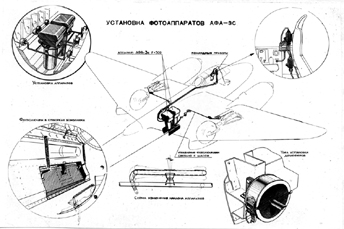
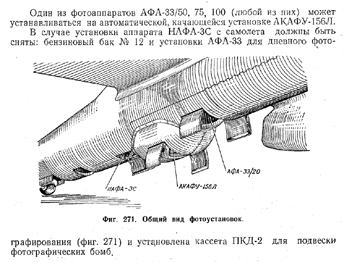 CIA reports give us some information about the target towing activities carried out by the "Tu-2" based in Schönwalde. Now we know that these were Tu-6 as well as UTu-6 and we find the proof in black and white in the article "Flight logs" already mentioned. There was therefore a target towing section within the 48.OGRAP and it was there that the crews of the target towing section of the 931.OKRAP came in 1953 to train on the Tu-6 that were to replace their old war-era "Bostons". It is likely that all or part of the Tu-6 from the 48.OGRAP were given to the 931.OKRAP (2) since the unit in turn was re-equipped with Il-28R the same year. The regiment left Schönwalde in mid-1953 for Welzow. It is possible that the conversion to Il-28 took place in Oranienburg. But a few months later, still in 1953, the unit finally moved to Kolomiya in Ukraine.
Another guards independent reconnaissance unit was based in Oranienburg from the end of March 1955. The 98.OGRAP "Vistula" was set up in April 1942 as the 4.OAPDR in Monino. In early 1943, the unit included Pe-2 as well as Pe-3 and P-39 (3). A-20 (named "Boston" in USSR) were also delivered later and the P-39 were replaced by Yak-9DD (30% more fuel capacity than the Yak-9D). Light aircraft such as the Po-2 were also used by this type of unit for liaison or to carry photographs to the HQs. On June 17, 1943, the regiment was transformed into a Guards unit, becoming the 98.OGRAP. The unit flew Il-28R in Oranienburg until October 1956 when the regiment moved to Shatalovo. According to a BND report, each Il-28-armed bomber division had a reconnaissance regiment attached to it. If this is correct, then the 98.OGRAP would have been attached to the unidentified BAD (221 or 32?) whose HQ and a regiment were stationed in Oranienburg in 1955. For what reason? Probably just to make it easier to maintain aircraft of the same type.
CIA reports give us some information about the target towing activities carried out by the "Tu-2" based in Schönwalde. Now we know that these were Tu-6 as well as UTu-6 and we find the proof in black and white in the article "Flight logs" already mentioned. There was therefore a target towing section within the 48.OGRAP and it was there that the crews of the target towing section of the 931.OKRAP came in 1953 to train on the Tu-6 that were to replace their old war-era "Bostons". It is likely that all or part of the Tu-6 from the 48.OGRAP were given to the 931.OKRAP (2) since the unit in turn was re-equipped with Il-28R the same year. The regiment left Schönwalde in mid-1953 for Welzow. It is possible that the conversion to Il-28 took place in Oranienburg. But a few months later, still in 1953, the unit finally moved to Kolomiya in Ukraine.
Another guards independent reconnaissance unit was based in Oranienburg from the end of March 1955. The 98.OGRAP "Vistula" was set up in April 1942 as the 4.OAPDR in Monino. In early 1943, the unit included Pe-2 as well as Pe-3 and P-39 (3). A-20 (named "Boston" in USSR) were also delivered later and the P-39 were replaced by Yak-9DD (30% more fuel capacity than the Yak-9D). Light aircraft such as the Po-2 were also used by this type of unit for liaison or to carry photographs to the HQs. On June 17, 1943, the regiment was transformed into a Guards unit, becoming the 98.OGRAP. The unit flew Il-28R in Oranienburg until October 1956 when the regiment moved to Shatalovo. According to a BND report, each Il-28-armed bomber division had a reconnaissance regiment attached to it. If this is correct, then the 98.OGRAP would have been attached to the unidentified BAD (221 or 32?) whose HQ and a regiment were stationed in Oranienburg in 1955. For what reason? Probably just to make it easier to maintain aircraft of the same type.
notes
(1)
The village of Warnitz (Warnice) is located just south of the former Luftwaffe airfield formerly called Fliegerhorst Klützow. It is therefore to this
airfield, occupied by the Soviets in March 1945 and restored, that Warnitz corresponds. This airfield remained active after the war and was
expanded from the 1950s. Known as Kluczewo-Stargard, the airbase was home of the 159.GvIAP of the 4.VA equipped withe Su-27 which left on
July 13, 1992.
(2)
The number of aircraft in service should be considered with circumspection and should not be based on the theoretical standard numbers. Thus,
according to the CIA, the unit carrying out target towing based in Schönwalde only operated about fifteen aircraft. There is no mention of more
aircraft dedicated to reconnaissance, for example.
(3) The third squadron was equipped with six P-39Ds in October 1942. They carried an AFA-I or AFA-B camera and the wing-mounted machine
guns were usually removed.
 |
Plan du site - Sitemap |  |
